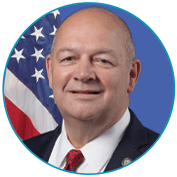 AUVSI’s XPONENTIAL 2021 kicked off in Atlanta this week, and it’s clear from the buzz that the drone industry is happy to back and gathering again.
AUVSI’s XPONENTIAL 2021 kicked off in Atlanta this week, and it’s clear from the buzz that the drone industry is happy to back and gathering again.
 FAA Chief Administrator Steve Dickson took the stage for a keynote addressed to a full – appropriately socially distanced – global audience of drone industry stakeholders.
FAA Chief Administrator Steve Dickson took the stage for a keynote addressed to a full – appropriately socially distanced – global audience of drone industry stakeholders.
Dickson comes from a manned aircraft background, as an executive for Delta Airlines, and his approach to drone integration reflects that: Dickson is justifiably proud of the safety record that the U.S. holds in aerospace, and made it clear that the public has a right to expect that safety record to continue. After the requisite statement on safety, Dickson provided a valuable update on the progress of drone regulation and integration.
Trusted Integration
Dickson says that the FAA goal is “trusted integration.” “Trusted Integration,” he says, “means that we have confidence that we’re all on the same page to get drones safely and efficiently integrated into the airspace.” With the cooperative rulemaking committees in place at the FAA – from the Drone Advisory Committee to the newly formed BVLOS Advisory Rulemaking Committee – help to ensure that all parties understand the goals and the reasons behind drone policy.
“I see policy as a protective sphere around the airplane,” he said. “For drone integration, we’ve done our best to allow for as much innovation and operation as possible… we’re actually at the point right now where we are bumping up against the edges of what’s practical.”
Next Steps: BVLOS Flight, Drone Certification – and FAA Reorganization
While Dickson calls Remote ID “a significant milestone in our journey,” flight beyond visual line of sight (BVLOS) and aircraft certification are next on the agenda for the agency.
For BVLOS flight, Dickson says that the agency is moving quickly, and expects to receive feedback from the BVLOS Advisory Committee by late fall, which should result in a notice of proposed rulemaking. Aircraft certification is also changing: the FAA is evolving the way that they certify aircraft, though the MOSAIC program – which stands for Modernization of Special Airworthiness Certificates. That evolution, Dickson explains, appropriately scales the aircraft certification process to accommodate new aircraft.
Finally, Dickson said that the FAA itself is changing. “We’re evolving the agency,” Dickson said, in order to make it easier for flyers to find the resources that they need and to integrate unmanned systems into the manned aircraft control systems.
“It’s important that we’re able to operate in harmony with manned aviation,” said Dickson.

Miriam McNabb is the Editor-in-Chief of DRONELIFE and CEO of JobForDrones, a professional drone services marketplace, and a fascinated observer of the emerging drone industry and the regulatory environment for drones. Miriam has penned over 3,000 articles focused on the commercial drone space and is an international speaker and recognized figure in the industry. Miriam has a degree from the University of Chicago and over 20 years of experience in high tech sales and marketing for new technologies.
For drone industry consulting or writing, Email Miriam.
TWITTER:@spaldingbarker
Subscribe to DroneLife here.







[…] as Administrator Steve Dickson promised publication “sometime before the end of the year” in his address at a drone conference earlier this […]